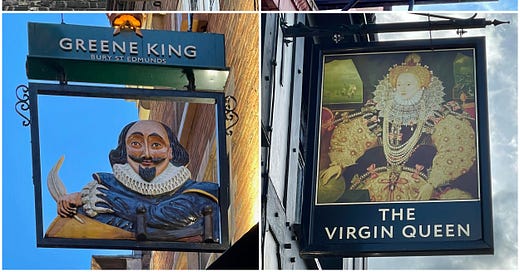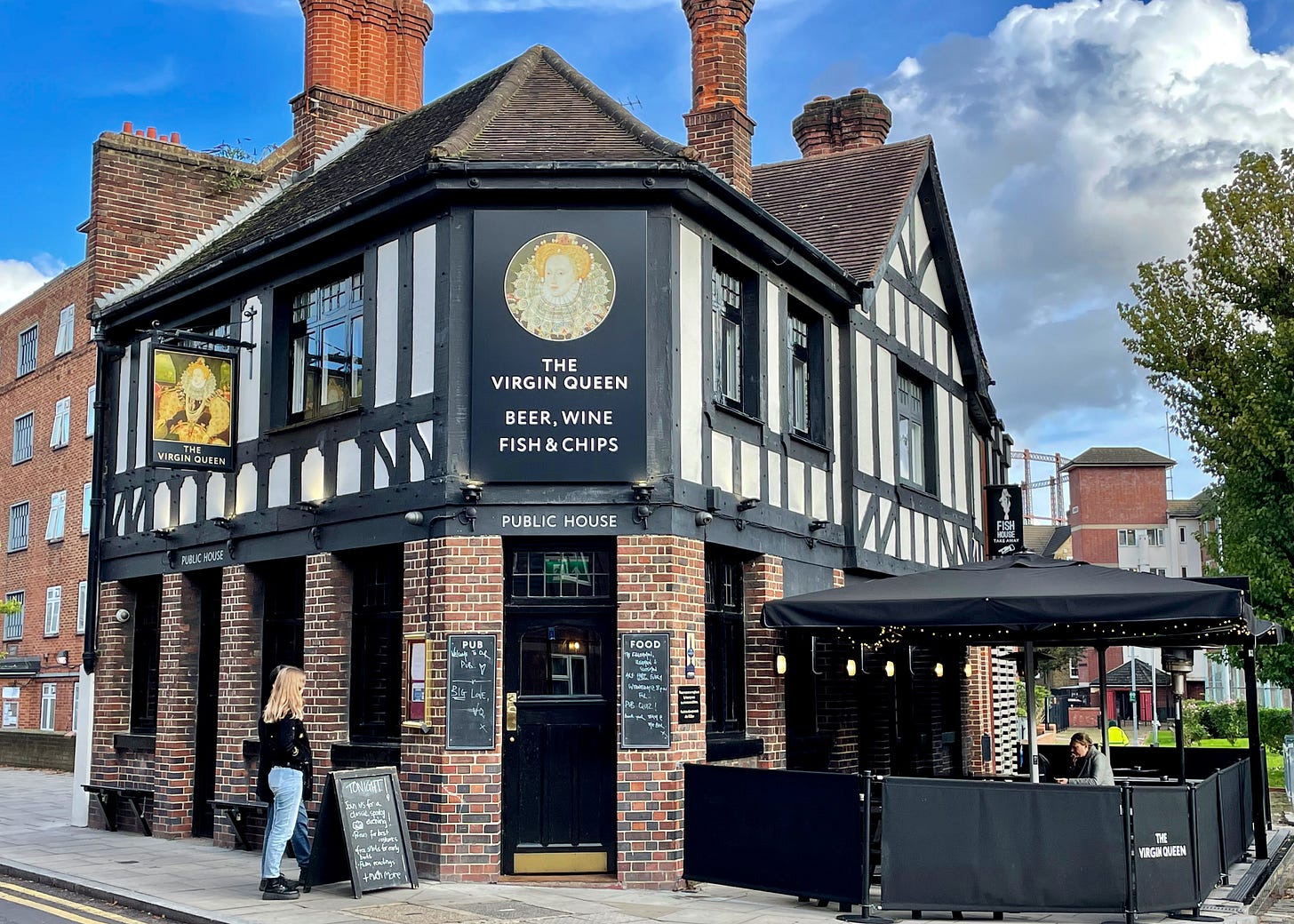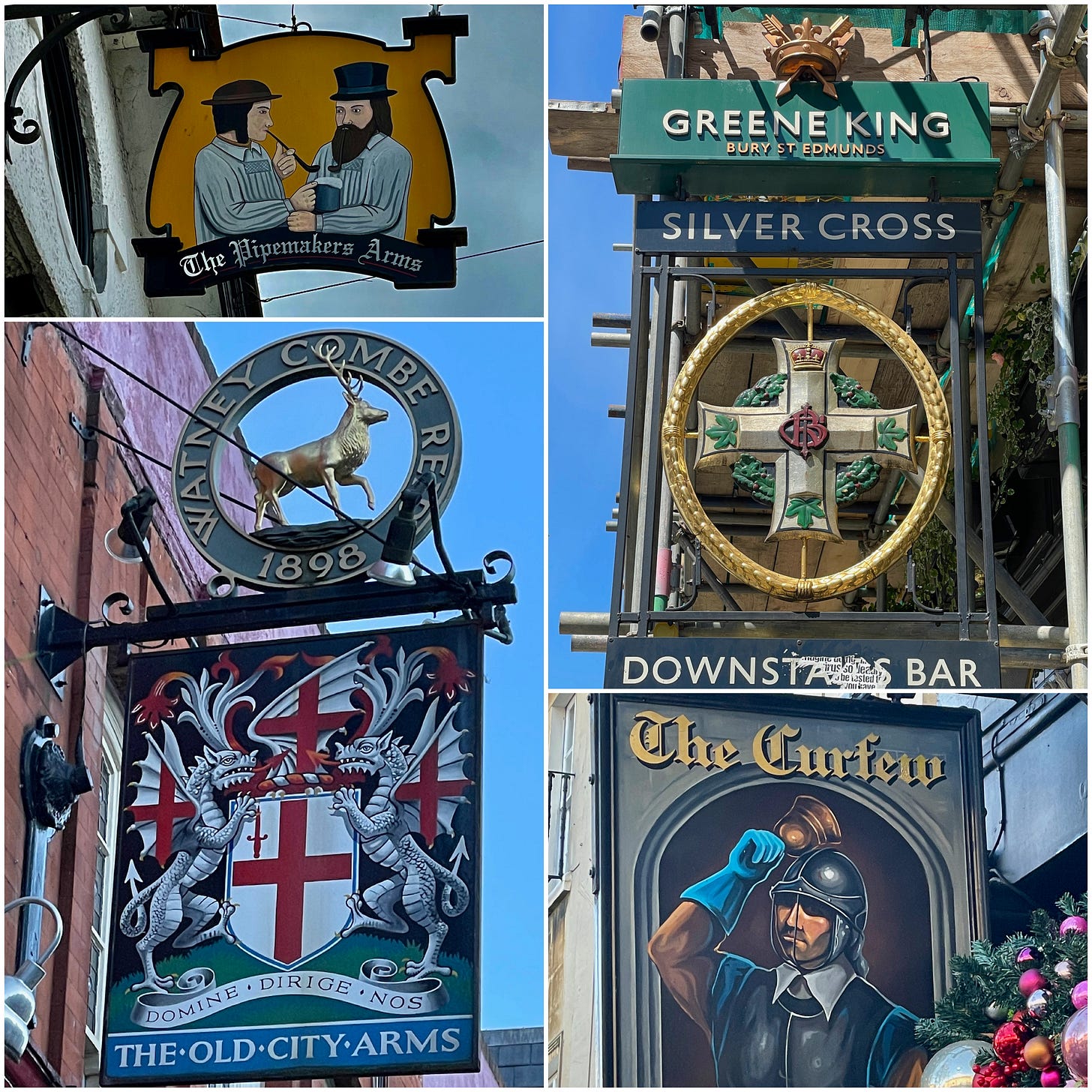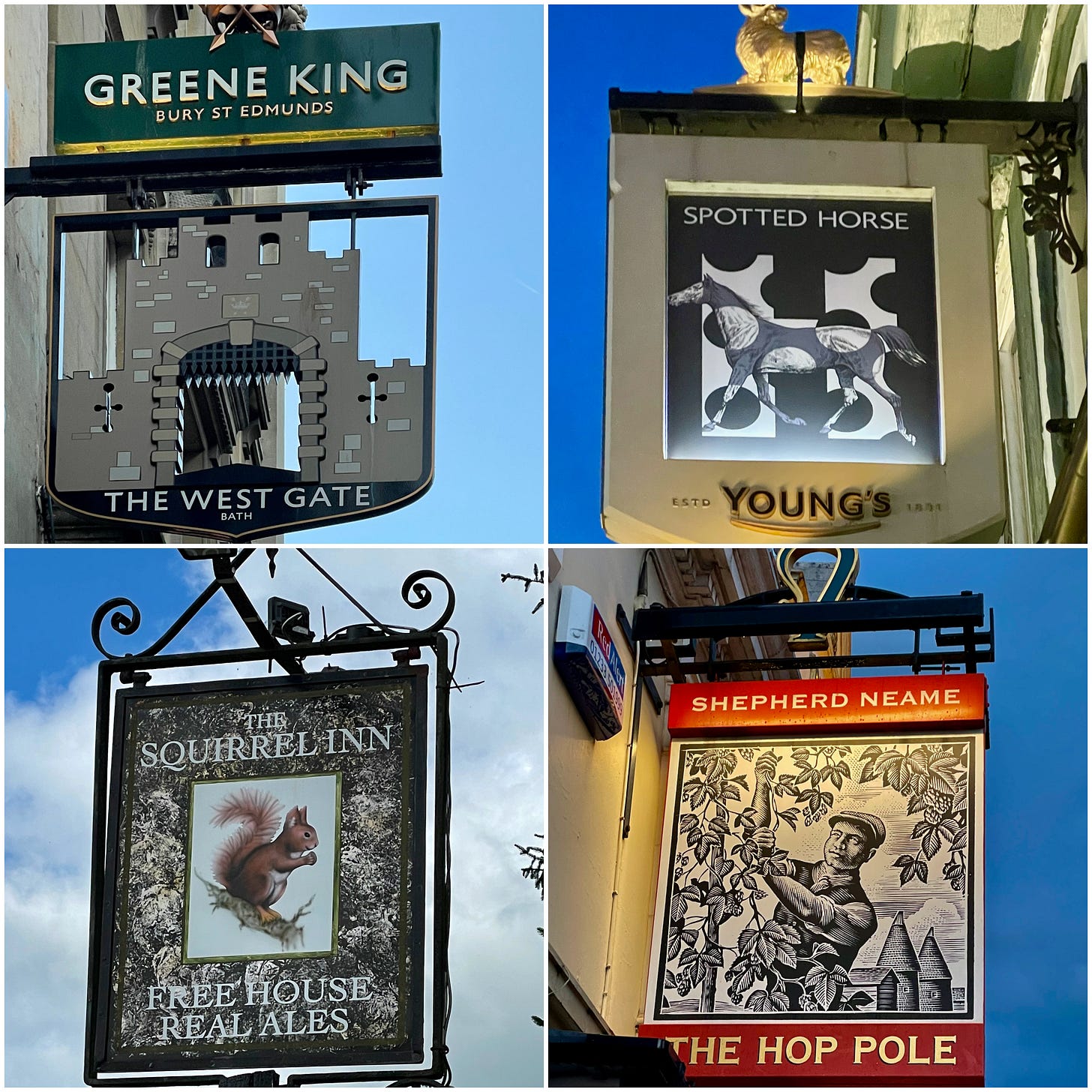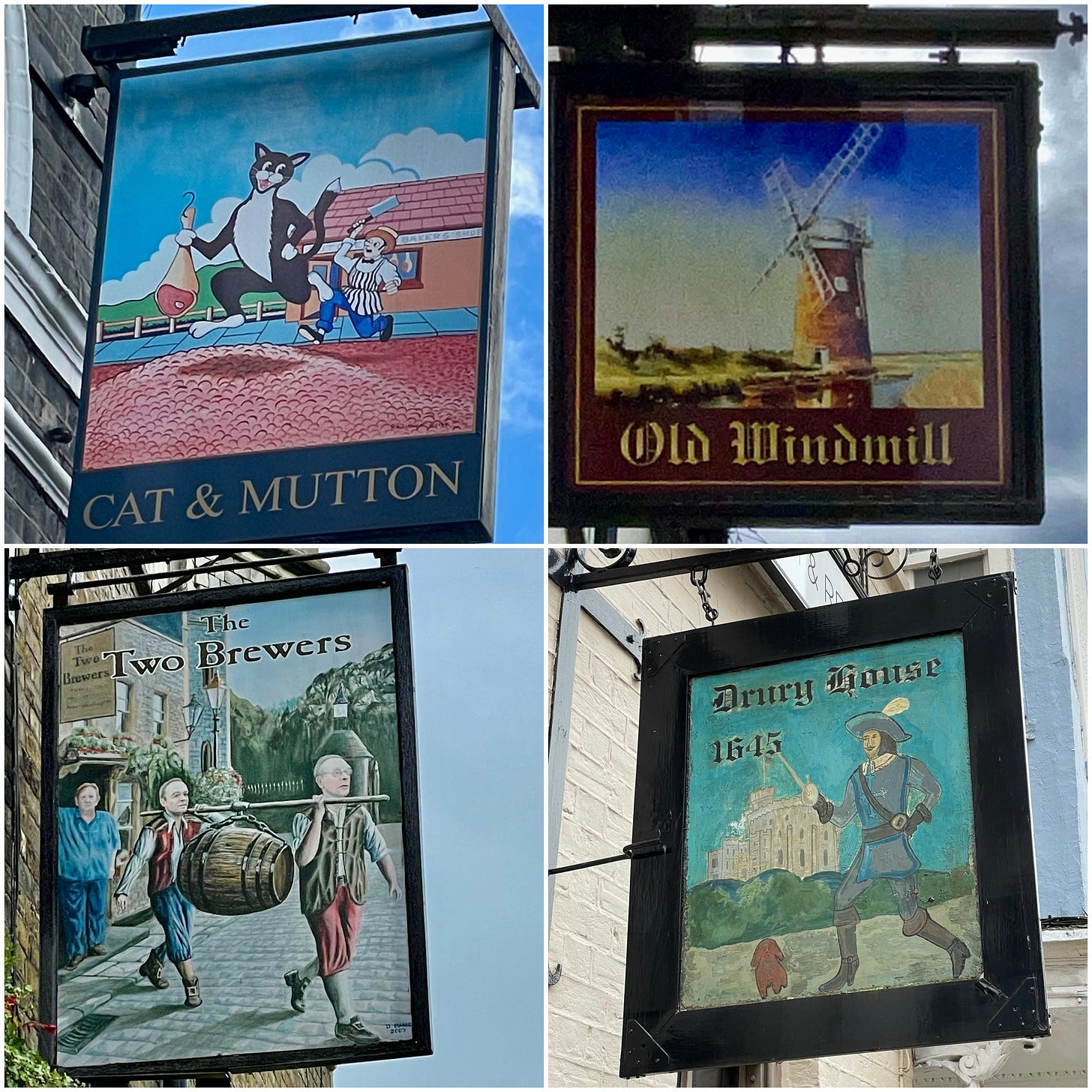Signs from several pubs around the London area.
Dear friends and fellow countrymen,
By now you and all of England have finished your New Year’s Eve binges, suffered through the hangover and are well into “dry January”, which could possibly last through the NFL playoffs, but doubtfully endure the SuperBowl on 15 February. If you’ve made it to the present moment, then you are likely doing better than the Brits, which have had to suffer through the FA Cup, an English football (soccer) free-for-all in which any team in any league, no matter how low (here’s looking at you, Nottingham Forest) plays against the top teams of the Premier League (Manchester City, Chelsea, etc.). It’s a gambler’s free-for-all.
It’s also a New-Year-pledge-breaking, cry-in-your-pint ritual of glory and misery (here’s looking at you, Arsenal), leaving many a sodden soul peering forlornly down the street at their neighborhood pub, where friends gather on stained carpets, collect a glass full of brown yeast on a wet towel and yell at the television.
And while pubs might make for fine places to drink (even the English do the ‘dive bar’ better), what’s with those names?
The Virgin Queen pub, located on Goldsmiths Row in Hackney, was once called Albion and Duke of Sussex, respectively, but when both the football team, West Bromwich Albion, and Prince Harry fell out of favour, owners decided to honour a reliable source.
The commissioning of these some 50,000 pubs in the UK, especially the ones with the strangest decor and gnarliest carpeting, dates back centuries — the oldest verified by Guinness: Ye Olde Fighting Cocks in St. Albans (795 AD). Since literacy was in short supply in Britain’s dark ages, when it came to naming and signifying pub signs, many owners used hops, wheat and other mead-related paraphernalia to indicate to passers-by they could find libations there. English Royalty first interfered in this tradition in 1393, when King Richard II passed an act requiring pubs take his emblem, a White Hart, to identify them as legitimate, or having passed the test of the local ale taster — an official government role.
Soon enough, however, when farmers finished a day’s work or knights completed that evening joust, and both wanted to meet their friends for a drink, “see you at the White Hart” beget confusion. Pub owners next tried random symbols to paint on signs in order to distinguish one pub from another. For example, farmers and jousters could meet outside the "the sign of the Eagle and Child » Although they probably couldn’t discern the phrase « Eagle and Child » from « Bear and Staff », that “ah-ha” moment set in when they spotted the graphic design.
The Shakespeare's Head, located on Carnaby Street in Soho since 1735, was originally owned by Thomas and John Shakespeare, distant relatives of the Bard. The sign is a reproduction of Martin Droeshouts' portrait of Shakespeare; gazing down at the busy street is a life-size bust, which upon close examination, reveals a hand lost during World War II.
Besides King Richard II, the more clever royals soon saw an opportunity to spread their “brand” beyond the castle walls (keep your eyes open for Ye Olde Meghan & Harry someday). When King Henry VIII split from the Catholics in the early 16th century, what better way to establish himself as the chief of the Church of England than to stick his head with a crown on pub signs across the country? After King James I joined England and Scotland in 1603, he made sure to stick a red lion (one of Scotland's emblems) on all pub signs. The names proved as popular as « Marmite’s Love it or Hate it » jingle. To this day, a Google search pulls up about 20 different “Crowns” and "Red Lions” within the greater London area. Some differentiate themselves by adding inanimate objects — (The Red Lion & Pineapple in Acton, The Crown & Cushion in Waterloo). Creative, if not a little head-scratching.
Thé English, like all things English, especially World War I, take this matter rather seriously, even devoting journal papers to it. In “Reinvention: A Journal of Undergraduate Research”, Catherine Dent, a history student at the University of Warwick posits that pub signs “give us valuable insight into early modern mentalities, geographies and commercial spaces.”
“But though the Signes are neither good nor bad,/There's Wine, Good, Bad, Indifferent, to be had” — a 1630 line of verse describing the need for pub signs, as quoted in a journal paper by Catherine Dent at the University of Warwick.
As towns and villages grew, according to Dent, so did the numbers of inns and alehouses. Barkeeps needed to branch out — there were only so many Kings’ heads to go around. “The sign no longer merely had to convey information but to set the establishment apart from its rivals and enable it to be discussed and recommended to others,” Dent writes. Some pub owners used rebuses to translate the owner's name into pictorial form; a hare and bottle stood for Harebottle, and two cocks for Cox.
But, as Dent says, signs didn’t necessarily provide an identification, but rather, an affiliation. This resulted in a bit of confusion. The owner of the pub named “The Leg and Star”, likely had no naughty thoughts on his mind, but wanted to display the insignia of the Order of the Garter, an important designation of knighthood in England. Villagers, however, not recognising the symbols, simply called it as they saw it: a leg and a star. After the capture of the town of Boulogne by Henry VIII in 1544, the Boulogne Mouth, referring to the harbour of the French city, became a popular sign across England. Just one problem: the difficulties with the French pronunciation meant it was commonly known as the Bull and Mouth.
Some of the tamer pub signs illustrating either their surroundings or their purposes. Photos clockwise from top left: A castle gate in Bath; spotted horses in Putney; hop poles in Wandsworth and squirrels in Dorset.
Although some pubs and tavens throughout their lifespans kept a variation on the same sign for hundreds of years, many progressed through different incarnations, especially in reaction to societal upheavals and politics. With the coming of the Reformation in the sixteenth century many of the symbols of the Middle Age, such as the star, angel or crossed keys — which had previously invited religious pilgrims into their accommodations — hid their canonical connotations. The St. Catherine and Wheel, for example, became the Cat and Wheel or the Cat and Fiddle.
Other pub proprietors chose to use their signs as a way of showing their support or their opposition to the politics of the day. One day, a pub could take on the name, the King's Head follozknb Charles I's execution in 1649 and Cromwell's Head following the Restoration.
Some pub signs remain historical, but not politically correct. Built in 1849, The Arab Boy was bequeathed by its builder, Henry Scarth, to Yussef Sirric, the Arab servant he brought back from Turkey. Sirric ran the pub for the rest of his life — and kept the sign.
It could be finally be said that the 17th, 18th and 19th century pub signs were the modern equivalent of gracing the cover of OK magazine. National heroes such as Sir Francis Drake, local celebrities like George Steadman the Grasmere Wrestler and even international figures such as William Tell all appeared on pubs signs in London.
Moreover, as the Industrial Revolution spread throughout England, people had more free time and more money to spend. Although there had been legislation appearing all over Europe to replace signs with street numbers, many survived as advertising, especially if they were painted by renowned artists, such as Richard Hopkins Leach (1794-1851) who envisioned Cambridge’s old castle on a mound into a romantic turreted castle by the sea, where handsome British officers frequent for the Old Castle pub.
Photos clockwise from top left: the Cat & Mutton was likely the “Cattle and Shoulder of Mutton” from the “many drovers and agricultural workers arriving in London to sell there various beasts in the markets; The Old Windmill in Coventry dates back to 1451 and pays tribute to a mill on the River Sherbourne; the Drury House in Windsor housed goods for the castle, as well as provided a secret passage by which Nell Gwynn, Charles II’s favorite mistress could have secret liaisons with the King; and the Two Brewers is self explanatory.
And lastly, signs pandered to a certain audience, or they just told a good story that would appeal to… somebody. Many establishments in London served ‘Dutchmen' and were named as such. Others, such as the Narrow Boat, catered to barge owners and their fans near the Islington canals. The Drunken Duck in Ambleside, on the other hand, owes its namesake to a beer barrel enjoyed to excess by the ducks in the yard.
Photos clockwise from top left: Woodin’s Shades refers to wine merchant, William Woodin, and the old word for a wine vault; The Owl & Pussycat, which replaced the Crown, refers to a poem by Edward Lear; the Cat’s Back liklely has everything to do with a long hill shaped like a Cat’s Back in Hertfordshire; and Nell Gwynn’s in Windsor pays homage to one of King Charles II’s famous mistresses.
But what about that pesky Elephant and Castle? Buyer beware on the legend of English pub names. It was once widely circulated that the Elephant and Castle was substututed from the cockney corruption of the phrase "La Infanta de Castilla”, a reference to Eleanor of Castile. Not true. Most likely, the pub gained its name from a crest used by a group of ivory merchants known as the Worshipful Company of Cutlers, whose crest had an elephant carrying a castle.
Ever Yours,
Adrian
English or American Rebuttal
If you or a friend want to debate any thought in this newsletter, please leave a comment!
Housekeeping:
If you enjoy this newsletter — and the photographs — I ask that you subscribe. Your small donation goes a long way toward my goal of what the English call “permanent leave to remain” and the Americans call “to stay in the country.”

